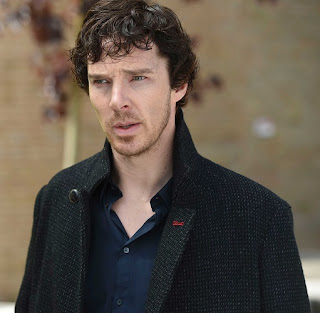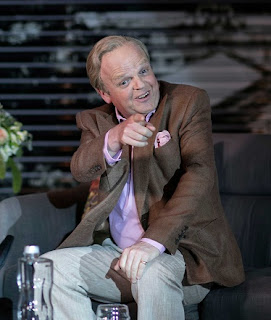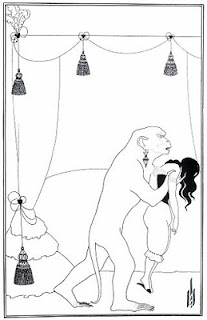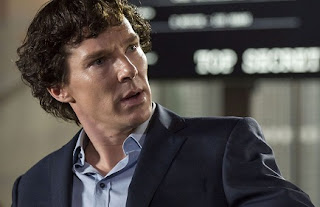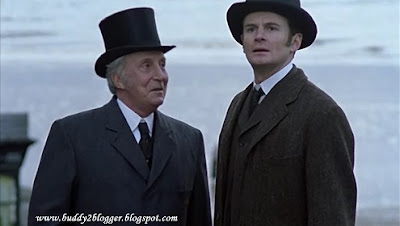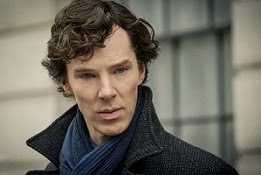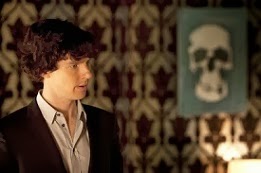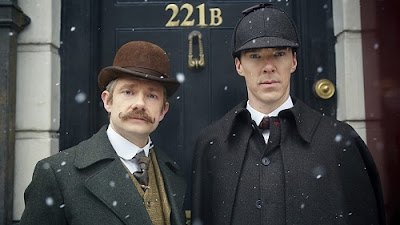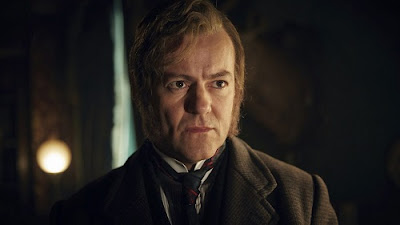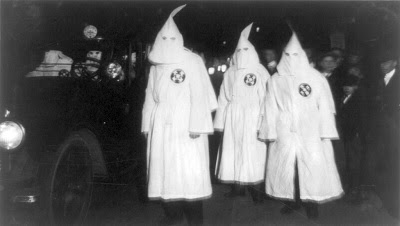There will be spoilers throughout and the readers who are yet to watch the episode are recommended to skip this post. Here are the nods to Arthur Conan Doyle's works:
1. The episode's title “The Lying Detective” - Reference to the short story The Adventure of the Dying Detective, on which the episode is based on. The original had Holmes faking a deadly affliction to fool Culverton Smith into confessing to the murder of his nephew (Victor Savage) and also of the attempted murder of Holmes himself.
2. Faith's desperate pleas to Sherlock: “Please.. I have no else to turn to....You are my last hope.” - Holmes states in The Sign of the Four: “I am the last and highest court of appeal in detection. When Gregson or Lestrade or Athelney Jones are out of their depths -which, by the way, is their normal state - the matter is laid before me. I examine the data, as an expert, and pronounce a specialist's opinion.”
3. Sherlock is convinced that Faith is about to commit suicide and yells at her: “Your life is not your own. Keep your hands off it.” - In The Adventure of the Veiled Lodger, Holmes and Watson listen to Eugenia Ronder's tragic story as to how she lost her beauty. Then Holmes tells her strongly: “Your life is not your own. Keep your hands off it.”
4. Sherlock's deductions about Faith sitting in the passenger seat based on the marks on her skirt. Faith confirms that she came in a taxi. - In The Adventure of the Speckled Band, Holmes deduces that his client (Helen Stoner) came in a dog-cart: “The left arm of your jacket is spattered with mud in no less than seven places. The marks are perfectly fresh. There is no vehicle save a dog-cart which throws up mud in that way, and then only when you sit on the left-hand side of the driver.”
5. Sherlock guessing the self-inflicted scars on Faith's left forearm that she deliberately hides under her sleeve. Faith confirms that Sherlock is correct. - In The Adventure of the Speckled Band, Holmes observes “five little livid spots, the marks of four fingers and a thumb that were printed upon the white wrist” of his client (Helen Stoner). In this case, it is Helen's stepfather Dr Grimesby Roylott who inflicts these wounds out of spite.
6. When another character interrupts Mycroft's call with the Prime Minister to inform him that Sherlock has left the flat, Mycroft retorts: “Was it on fire?” - Possible reference to The Final Problem. In the story, Moriarty's agents set the Baker Street rooms on fire.
7. Sherlock's line: “The game's afoot.” - Sherlock Holmes awakens Dr John Watson in The Adventure of the Abbey Grange and implores him: “Come, Watson, come! ... The game is afoot. Not a word! Into your clothes and come!”
8. Sherlock's remark about Culverton Smith: “That creature, that rotting thing, is a living breathing coagulation of human evil, and if the only thing I ever do in this world is drive him out of it, then my life will not have been wasted.” - In The Final Problem, Holmes states about Professor Moriarty: “I tell you, Watson, in all seriousness, that if I could beat that man, if I could free society of him, I should feel that my own career had reached its summit, and I should be prepared to turn to some more placid line in life.”
Click on the link below to order your copy of Season 4:
9. Sherlock angrily tells John: “I have been many things, John, but when I ever been a malingerer?” - In The Adventure of the Dying Detective, Holmes tells Dr Watson: “Malingering is a subject upon which I have sometimes thought of writing a monograph.”
10. Sherlock tells the children at the hospital: “The main feature of interest in the field of criminal investigation is not the sensational aspects of the crime itself, but rather ... the iron chain of reason from cause to effect that reveals step by step the solution. That is the only truly remarkable aspect of the entire affair.” -
In The Sign of the Four, Holmes criticizes Dr Watson's previous write up (A Study in Scarlet): “I glanced over it ... Honestly, I cannot congratulate you upon it. Detection is, or ought to be, an exact science, and should be treated in the same cold and unemotional manner. You have attempted to tinge it with romanticism, which produces much the same effect as if you worked a love-story or an elopement into the fifth proposition of Euclid ... The only point in the case which deserved mention was the curious analytical reasoning from effects to causes by which I succeeded in unraveling it.”
11. At the hospital, Sherlock refers to the case of Blessington the poisoner that involved 5 suspects - Possible reference to The Adventure of the Resident Patient, which involved the Worthingdon bank gang. The gang had 5 members: Blessington/Sutton, Biddle, Hayward, Cartwright and Moffat. Yes, Steven could have very well scripted a meta reference to himself!
12. Culverton Smith asks John: “You really a doctor? ... Not a medical doctor, you know. Not just feet, or media studies or something....Are you?” and sarcastically refers to him as “Doctor Watson.”
AND
After John rescues Sherlock from Culverton, John asks him if he is ok. Sherlock replies: “No of course I’m not ok. Malnourished, double kidney failure, and frankly I’ve been off my tits for weeks. What kind of a doctor are you?” -
In The Adventure of the Dying Detective, it is Holmes who tells Dr Watson: “If I am to have a doctor whether I will or not, let me at least have someone in whom I have confidence... after all, you are only a general practitioner with very limited experience and mediocre qualifications. It is painful to have to say these things, but you leave me no choice.”
13. Nurse Cornish's comment about Sherlock's physical strength: “And yeah, he’s made a terrible mess of himself, but he’s awfully strong, so must look on the bright side.” -
Dr Watson writes about his first meeting with Sherlock Holmes in A Study in Scarlet - “How are you?” he said cordially, gripping my hand with a strength for which I should hardly have given him credit. “You have been in Afghanistan, I perceive.”
Holmes displays his strength (after Dr Grimesby Roylott's departure) in The Adventure of the Speckled Band - “He seems a very amiable person,” said Holmes, laughing. “I am not quite so bulky, but if he had remained I might have shown him that my grip was not much more feeble than his own.” As he spoke he picked up the steel poker and, with a sudden effort, straightened it out again.
14. There is an old envelope with address “S. Holmes 156 Montague St” on the mantelpiece at 221 B Baker Street.
Holmes tells Dr Watson in The Adventure of the Musgrave Ritual: “When I first came up to London I had rooms in Montague Street, just round the corner from the British Museum, and there I waited, filling in my too abundant leisure time by studying all those branches of science which might make me more efficient.”
15. Mrs Hudson explains about Sherlock's actions: “Unsolved case - shoot the wall.... Unmade breakfast - karate the fridge ... Unanswered question. Well, what does he do with anything he can’t answer John, every time?” John answers: “He stabs it.” -
Dr Watson writes in The Adventure of the Musgrave Ritual:
“..... when I find a man who keeps ... his unanswered correspondence transfixed by a jack-knife into the very centre of his wooden mantelpiece, then I begin to give myself virtuous airs. I have always held, too, that pistol practice should be distinctly an open-air pastime; and when Holmes, in one of his queer humors, would sit in an arm-chair with his hair-trigger and a hundred Boxer cartridges, and proceed to adorn the opposite wall with a patriotic V. R. done in bullet-pocks, I felt strongly that neither the atmosphere nor the appearance of our room was improved by it.”
16. After hearing Irene's customized ringtone, John asks Sherlock and The Woman have “a night of passion in High Wycombe?”. Sherlock replies: “I once caught a triple poisoner in High Wycombe.” -
In The Sign of the Four, Holmes states: “I assure you that the most winning woman I ever knew was hanged for poisoning three little children for their insurance-money, and the most repellent man of my acquaintance is a philanthropist who has spent nearly a quarter of a million upon the London poor.”
This is one of the best Canonical references in the series so far, as Moffat has referred to both Irene Adler and Culverton Smith. Hats off to Moffat!
17. Sherlock expresses his lack of interest in getting involved with Irene Adler: “As I have explained to you many times before, romantic entanglement, while fulfilling for other people...”
John interrupts: “... would complete you as a human being”
Sherlock responds: “That does not even mean anything.”
- Dr Watson writes about Holmes' feelings towards The Woman in A Scandal in Bohemia: “To Sherlock Holmes she is always the woman ... It was not that he felt any emotion akin to love for Irene Adler. All emotions, and that one particularly, were abhorrent to his cold, precise but admirably balanced mind ... He never spoke of the softer passions, save with a gibe and a sneer.”
18. John's therapist reveals her true identity as Eurus, the sister of the Holmes brothers. She also explains that the name means “East Wind.” -
In His Last Bow, Holmes tells Dr Watson: “There's an east wind coming, Watson.”
Watson: “I think not, Holmes. It is very warm.”
Holmes: “Good old Watson! You are the one fixed point in a changing age. There's an east wind coming all the same, such a wind as never blew on England yet. It will be cold and bitter, Watson, and a good many of us may wither before its blast. But it's God's own wind none the less, and a cleaner, better, stronger land will lie in the sunshine when the storm has cleared.”
Interestingly, at the climax of His Last Vow, Sherlock tells John: “The East Wind takes us all in the end ... It’s a story my brother told me when we were kids. The East Wind - this terrifying force that lays waste to all in its path ... It seeks out the unworthy and plucks them from the Earth. That was generally me.”
Other References
1. Sherlock mentions a case of the Drearcliffe House with one murder and ten suspects in which all of them were guilty - This is a reference to the Basil Rathbone-Nigel Bruce Sherlock Holmes movie: Sherlock Holmes and the House of Fear. There are seven single men living together in Drearcliffe House, a Scottish castle. One by one, they start dying till only one is left. Holmes however figures out that the remaining six had conspired to have the seventh arrested on murder charges for insurance money.
2. Culverton refers to H H Holmes as his favorite serial killer. He further says that H H Holmes loved the dead and that he mass produced them. Later, Smith explains to a hospitalized Sherlock: “I built this whole wing... kept firing the architects and builders, so no one knew quite how it all fitted together.”.Murder Castle, done right.” - This is a reference to Dr Henry Howard Holmes (H H Holmes), the character from the novel “The Devil in the White City”. H H Holmes was a real life serial killer and took his victims to his World's Fair Hotel and killed them there. He also fired the construction workers so that he was the only one with complete knowledge of the building.
3. Sherlock's seemingly drug-induced crazy monologue (at 221 B Baker Street) that starts with the following words: “Once more unto the breach, dear friends, once more...” is taken from William Shakespeare's play “Henry V” and is spoken by King Henry.
4. The Zoo case/Case of the killer Orangutan brought up by Sherlock - Reference to the short story “The Murders in the Rue Morgue” by Edgar Allan Poe. An orangutan is the killer in this story.
This story is considered to be the first modern detective story and introduces the character of C. Auguste Dupin. Poe was a significant influence on Arthur Conan Doyle for creating Sherlock Holmes. Doyle mentions Poe in A Study in Scarlet - Dr Watson: “You remind me of Edgar Allen Poe’s Dupin. I had no idea that such individuals did exist outside of stories.” Holmes responds: “No doubt you think that you are complimenting me in comparing me to Dupin.... Now, in my opinion, Dupin was a very inferior fellow.... He had some analytical genius, no doubt; but he was by no means such a phenomenon as Poe appeared to imagine.”
Click here to read all my posts about BBC Sherlock.
1. The episode's title “The Lying Detective” - Reference to the short story The Adventure of the Dying Detective, on which the episode is based on. The original had Holmes faking a deadly affliction to fool Culverton Smith into confessing to the murder of his nephew (Victor Savage) and also of the attempted murder of Holmes himself.
2. Faith's desperate pleas to Sherlock: “Please.. I have no else to turn to....You are my last hope.” - Holmes states in The Sign of the Four: “I am the last and highest court of appeal in detection. When Gregson or Lestrade or Athelney Jones are out of their depths -which, by the way, is their normal state - the matter is laid before me. I examine the data, as an expert, and pronounce a specialist's opinion.”
3. Sherlock is convinced that Faith is about to commit suicide and yells at her: “Your life is not your own. Keep your hands off it.” - In The Adventure of the Veiled Lodger, Holmes and Watson listen to Eugenia Ronder's tragic story as to how she lost her beauty. Then Holmes tells her strongly: “Your life is not your own. Keep your hands off it.”
4. Sherlock's deductions about Faith sitting in the passenger seat based on the marks on her skirt. Faith confirms that she came in a taxi. - In The Adventure of the Speckled Band, Holmes deduces that his client (Helen Stoner) came in a dog-cart: “The left arm of your jacket is spattered with mud in no less than seven places. The marks are perfectly fresh. There is no vehicle save a dog-cart which throws up mud in that way, and then only when you sit on the left-hand side of the driver.”
5. Sherlock guessing the self-inflicted scars on Faith's left forearm that she deliberately hides under her sleeve. Faith confirms that Sherlock is correct. - In The Adventure of the Speckled Band, Holmes observes “five little livid spots, the marks of four fingers and a thumb that were printed upon the white wrist” of his client (Helen Stoner). In this case, it is Helen's stepfather Dr Grimesby Roylott who inflicts these wounds out of spite.
6. When another character interrupts Mycroft's call with the Prime Minister to inform him that Sherlock has left the flat, Mycroft retorts: “Was it on fire?” - Possible reference to The Final Problem. In the story, Moriarty's agents set the Baker Street rooms on fire.
7. Sherlock's line: “The game's afoot.” - Sherlock Holmes awakens Dr John Watson in The Adventure of the Abbey Grange and implores him: “Come, Watson, come! ... The game is afoot. Not a word! Into your clothes and come!”
8. Sherlock's remark about Culverton Smith: “That creature, that rotting thing, is a living breathing coagulation of human evil, and if the only thing I ever do in this world is drive him out of it, then my life will not have been wasted.” - In The Final Problem, Holmes states about Professor Moriarty: “I tell you, Watson, in all seriousness, that if I could beat that man, if I could free society of him, I should feel that my own career had reached its summit, and I should be prepared to turn to some more placid line in life.”
Click on the link below to order your copy of Season 4:
10. Sherlock tells the children at the hospital: “The main feature of interest in the field of criminal investigation is not the sensational aspects of the crime itself, but rather ... the iron chain of reason from cause to effect that reveals step by step the solution. That is the only truly remarkable aspect of the entire affair.” -
In The Sign of the Four, Holmes criticizes Dr Watson's previous write up (A Study in Scarlet): “I glanced over it ... Honestly, I cannot congratulate you upon it. Detection is, or ought to be, an exact science, and should be treated in the same cold and unemotional manner. You have attempted to tinge it with romanticism, which produces much the same effect as if you worked a love-story or an elopement into the fifth proposition of Euclid ... The only point in the case which deserved mention was the curious analytical reasoning from effects to causes by which I succeeded in unraveling it.”
11. At the hospital, Sherlock refers to the case of Blessington the poisoner that involved 5 suspects - Possible reference to The Adventure of the Resident Patient, which involved the Worthingdon bank gang. The gang had 5 members: Blessington/Sutton, Biddle, Hayward, Cartwright and Moffat. Yes, Steven could have very well scripted a meta reference to himself!
12. Culverton Smith asks John: “You really a doctor? ... Not a medical doctor, you know. Not just feet, or media studies or something....Are you?” and sarcastically refers to him as “Doctor Watson.”
AND
After John rescues Sherlock from Culverton, John asks him if he is ok. Sherlock replies: “No of course I’m not ok. Malnourished, double kidney failure, and frankly I’ve been off my tits for weeks. What kind of a doctor are you?” -
In The Adventure of the Dying Detective, it is Holmes who tells Dr Watson: “If I am to have a doctor whether I will or not, let me at least have someone in whom I have confidence... after all, you are only a general practitioner with very limited experience and mediocre qualifications. It is painful to have to say these things, but you leave me no choice.”
13. Nurse Cornish's comment about Sherlock's physical strength: “And yeah, he’s made a terrible mess of himself, but he’s awfully strong, so must look on the bright side.” -
Dr Watson writes about his first meeting with Sherlock Holmes in A Study in Scarlet - “How are you?” he said cordially, gripping my hand with a strength for which I should hardly have given him credit. “You have been in Afghanistan, I perceive.”
Holmes displays his strength (after Dr Grimesby Roylott's departure) in The Adventure of the Speckled Band - “He seems a very amiable person,” said Holmes, laughing. “I am not quite so bulky, but if he had remained I might have shown him that my grip was not much more feeble than his own.” As he spoke he picked up the steel poker and, with a sudden effort, straightened it out again.
Holmes tells Dr Watson in The Adventure of the Musgrave Ritual: “When I first came up to London I had rooms in Montague Street, just round the corner from the British Museum, and there I waited, filling in my too abundant leisure time by studying all those branches of science which might make me more efficient.”
15. Mrs Hudson explains about Sherlock's actions: “Unsolved case - shoot the wall.... Unmade breakfast - karate the fridge ... Unanswered question. Well, what does he do with anything he can’t answer John, every time?” John answers: “He stabs it.” -
Dr Watson writes in The Adventure of the Musgrave Ritual:
“..... when I find a man who keeps ... his unanswered correspondence transfixed by a jack-knife into the very centre of his wooden mantelpiece, then I begin to give myself virtuous airs. I have always held, too, that pistol practice should be distinctly an open-air pastime; and when Holmes, in one of his queer humors, would sit in an arm-chair with his hair-trigger and a hundred Boxer cartridges, and proceed to adorn the opposite wall with a patriotic V. R. done in bullet-pocks, I felt strongly that neither the atmosphere nor the appearance of our room was improved by it.”
16. After hearing Irene's customized ringtone, John asks Sherlock and The Woman have “a night of passion in High Wycombe?”. Sherlock replies: “I once caught a triple poisoner in High Wycombe.” -
In The Sign of the Four, Holmes states: “I assure you that the most winning woman I ever knew was hanged for poisoning three little children for their insurance-money, and the most repellent man of my acquaintance is a philanthropist who has spent nearly a quarter of a million upon the London poor.”
This is one of the best Canonical references in the series so far, as Moffat has referred to both Irene Adler and Culverton Smith. Hats off to Moffat!
17. Sherlock expresses his lack of interest in getting involved with Irene Adler: “As I have explained to you many times before, romantic entanglement, while fulfilling for other people...”
John interrupts: “... would complete you as a human being”
Sherlock responds: “That does not even mean anything.”
- Dr Watson writes about Holmes' feelings towards The Woman in A Scandal in Bohemia: “To Sherlock Holmes she is always the woman ... It was not that he felt any emotion akin to love for Irene Adler. All emotions, and that one particularly, were abhorrent to his cold, precise but admirably balanced mind ... He never spoke of the softer passions, save with a gibe and a sneer.”
18. John's therapist reveals her true identity as Eurus, the sister of the Holmes brothers. She also explains that the name means “East Wind.” -
In His Last Bow, Holmes tells Dr Watson: “There's an east wind coming, Watson.”
Watson: “I think not, Holmes. It is very warm.”
Holmes: “Good old Watson! You are the one fixed point in a changing age. There's an east wind coming all the same, such a wind as never blew on England yet. It will be cold and bitter, Watson, and a good many of us may wither before its blast. But it's God's own wind none the less, and a cleaner, better, stronger land will lie in the sunshine when the storm has cleared.”
Interestingly, at the climax of His Last Vow, Sherlock tells John: “The East Wind takes us all in the end ... It’s a story my brother told me when we were kids. The East Wind - this terrifying force that lays waste to all in its path ... It seeks out the unworthy and plucks them from the Earth. That was generally me.”
Other References
1. Sherlock mentions a case of the Drearcliffe House with one murder and ten suspects in which all of them were guilty - This is a reference to the Basil Rathbone-Nigel Bruce Sherlock Holmes movie: Sherlock Holmes and the House of Fear. There are seven single men living together in Drearcliffe House, a Scottish castle. One by one, they start dying till only one is left. Holmes however figures out that the remaining six had conspired to have the seventh arrested on murder charges for insurance money.
2. Culverton refers to H H Holmes as his favorite serial killer. He further says that H H Holmes loved the dead and that he mass produced them. Later, Smith explains to a hospitalized Sherlock: “I built this whole wing... kept firing the architects and builders, so no one knew quite how it all fitted together.”.Murder Castle, done right.” - This is a reference to Dr Henry Howard Holmes (H H Holmes), the character from the novel “The Devil in the White City”. H H Holmes was a real life serial killer and took his victims to his World's Fair Hotel and killed them there. He also fired the construction workers so that he was the only one with complete knowledge of the building.
3. Sherlock's seemingly drug-induced crazy monologue (at 221 B Baker Street) that starts with the following words: “Once more unto the breach, dear friends, once more...” is taken from William Shakespeare's play “Henry V” and is spoken by King Henry.
4. The Zoo case/Case of the killer Orangutan brought up by Sherlock - Reference to the short story “The Murders in the Rue Morgue” by Edgar Allan Poe. An orangutan is the killer in this story.
This story is considered to be the first modern detective story and introduces the character of C. Auguste Dupin. Poe was a significant influence on Arthur Conan Doyle for creating Sherlock Holmes. Doyle mentions Poe in A Study in Scarlet - Dr Watson: “You remind me of Edgar Allen Poe’s Dupin. I had no idea that such individuals did exist outside of stories.” Holmes responds: “No doubt you think that you are complimenting me in comparing me to Dupin.... Now, in my opinion, Dupin was a very inferior fellow.... He had some analytical genius, no doubt; but he was by no means such a phenomenon as Poe appeared to imagine.”
Click here to read all my posts about BBC Sherlock.
Image Sources: Hartswood Films, BBC Wales, Masterpiece theater, Wikipedia
You might also like:

